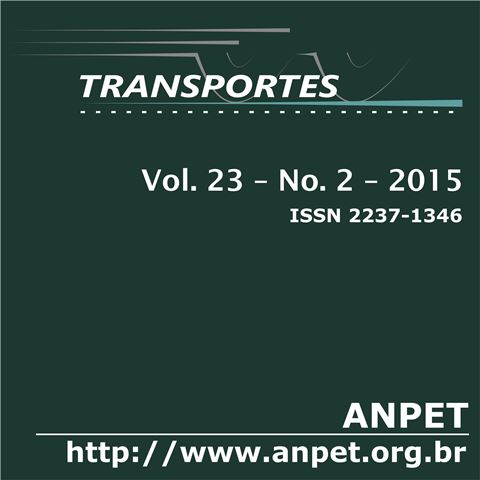.
DOI:
https://doi.org/10.14295/transportes.v23i2.862Keywords:
PBN, CDA, TAAM, Performance-Based Navigation.Abstract
The introduction of Performance-Based Navigation (PBN) procedures represents the search for optimization and better utilization of airspace, and its deployment is crucial for modernization programs of air navigation in progress in several countries, including Brazil. The implementation of this new type of procedure introduced changes in aircraft operation, the insertion of new procedures for air traffic controllers and pilots and the introduction of automation systems to support air operations. The aim of this paper is to analyze the benefits of performing PBN procedures and use of Continuous Descent Approaches (CDA) on the route Galeão-Guarulhos. The study applied fast-time simulation with the Total Airspace and Air-port Modeler (TAAM) and considered nine different aircraft models. Fuel consumed is used as a performance parameter. Study results showed the benefits of applying these techniques vary according aircraft models..Downloads
References
ANAC - Agência Nacional de Aviação Civil. Anuário Estatístico do Transporte Aéreo (2013). Dados Estatísticos e Econômicos de 2012. Brasília.
Banks, J. Handbook of simulation. Wiley Online Library, 1998. dx.doi.org/10.1002/9780470172445
Chandra, D. C.; Grayhem, R.; Butchibabu, A. Area Navigation and Required Navigation Performance Procedures and Depic-tions. Volpe Institute. 2012.
DECEA – Departamento de Controle do Espaço Aéreo (2013). Cartas de procedimento de voo por instrumento. Brasil.
ICAO- International Civil Aviation Organization (2013). Doc 9613. Performance-Based Navigation (PBN) Manual. 4th Edi-tion. Quebec, Canada.
ICAO- International Civil Aviation Organization (2010). Doc 9931.Continuous Descent Operation (CDO). 1th Edition. Que-bec, Canada
ICAO. International Civil Aviation Organization (2006). Doc 8168. Procedures for Air Navigation Services, Aircraft Opera-tions, PANS-OPS, Volume II, Construction of Visual and Instru-ment Flight Procedures. 5th Edition. Quebec, Canada.
Muller, D.; Uday, P.; Marais, K. B. (2011). Evaluation of the po-tential environmental benefits of RNAV/RNP arrival procedures. 11th AIAA ATIO conference Virginia. dx.doi.org/10.2514/6.2011-6932
Nolan, M. S (2010). Fundamentals of air traffic control. Cen-gage Learning.
Pidd, M. (1994). An introduction to computer simulation. Pro-ceedings of the 26th conference on Winter simulation. dx.doi.org/10.1109/WSC.1994.717064
Sprong, K. R. (2005). Measuring the effects of RNAV departure procedures on airport efficiency. Digital Avionics Systems Con-ference. dx.doi.org/10.1109/DASC.2005.1563329
Sprong, K. R. et al. (2005) Improving flight efficiency through terminal area RNAV. 6th USA/Europe Air Traffic Management R&D Seminar.
Sprong, K. R.; Mayer, R. H. (2007). Analysis of RNAV arrival operations with descend via clearances at Phoenix Airport. 26th IEEE/AIAA Digital Avionics Systems Conference. dx.doi.org/10.1109/dasc.2007.4391874
White JR, K. P.; Ingalls, R. G. (2009). Introduction to simu lation. Winter Simulation Conference. dx.doi.org/10.1109/wsc.2009.5429315
Downloads
Published
How to Cite
Issue
Section
License
Authors who submit papers for publication by TRANSPORTES agree to the following terms:
- The authors retain the copyright and grant Transportes the right of first publication of the manuscript, without any financial charge, and waive any other remuneration for its publication by ANPET.
- Upon publication by Transportes, the manuscript is automatically licensed under the Creative Commons License CC BY 4.0 license. This license permits the work to be shared with proper attribution to the authors and its original publication in this journal.
- Authors are authorized to enter into additional separate contracts for the non-exclusive distribution of the version of the manuscript published in this journal (e.g., publishing in an institutional repository or as a book chapter), with recognition of the initial publication in this journal, provided that such a contract does not imply an endorsement of the content of the manuscript or the new medium by ANPET.
- Authors are permitted and encouraged to publish and distribute their work online (e.g., in institutional repositories or on their personal websites) after the editorial process is complete. As Transportes provides open access to all published issues, authors are encouraged to use links to the DOI of their article in these cases.
- Authors guarantee that they have obtained the necessary authorization from their employers for the transfer of rights under this agreement, if these employers hold any copyright over the manuscript. Additionally, authors assume all responsibility for any copyright infringements by these employers, releasing ANPET and Transportes from any responsibility in this regard.
- Authors assume full responsibility for the content of the manuscript, including the necessary and appropriate authorizations for the disclosure of collected data and obtained results, releasing ANPET and Transportes from any responsibility in this regard.










